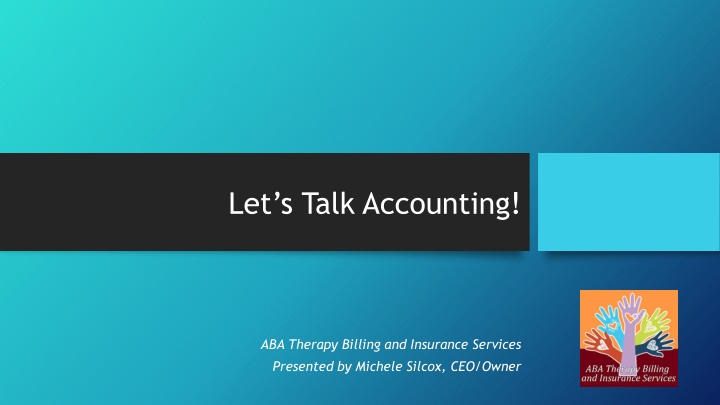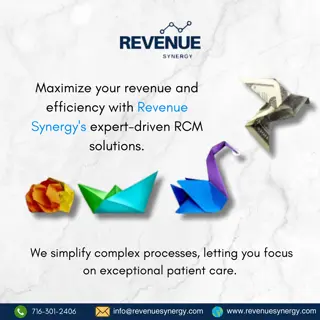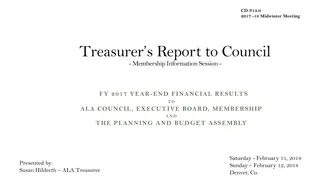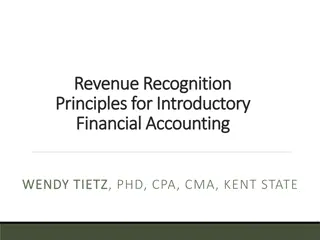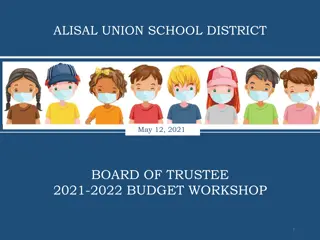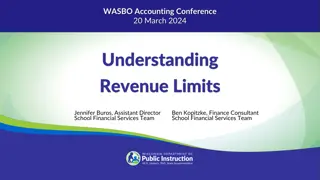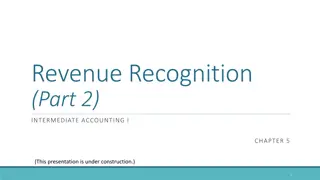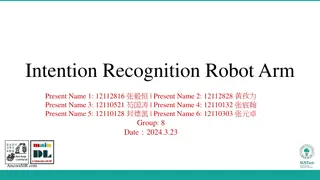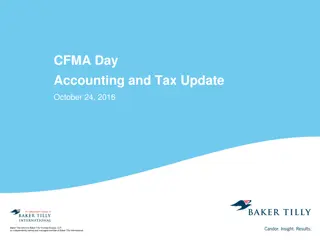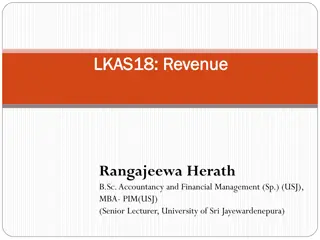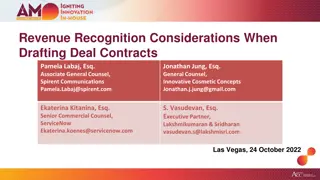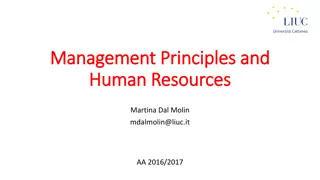Accounting Cycle and Revenue Recognition
This presentation covers accounting software, revenue recognition, cash vs. accrual basis accounting, and differences in revenue/expense recognition. It explains the practices in ABA therapy billing and insurance services. The content also delves into the comparison between practice management and accounting software, shedding light on the essential functions of each. Gain insights into the cash and accrual basis accounting methods and learn about when to apply each method for accurate financial reporting.
Download Presentation

Please find below an Image/Link to download the presentation.
The content on the website is provided AS IS for your information and personal use only. It may not be sold, licensed, or shared on other websites without obtaining consent from the author.If you encounter any issues during the download, it is possible that the publisher has removed the file from their server.
You are allowed to download the files provided on this website for personal or commercial use, subject to the condition that they are used lawfully. All files are the property of their respective owners.
The content on the website is provided AS IS for your information and personal use only. It may not be sold, licensed, or shared on other websites without obtaining consent from the author.
E N D
Presentation Transcript
Lets Talk Accounting! ABA Therapy Billing and Insurance Services Presented by Michele Silcox, CEO/Owner
Accounting Cycle Software and Revenue Recognition Payment Posting and Patient Balances Month End/Year End Reports Payroll/Expenses Billing/Revenue
Practice Management vs Accounting Software Practice Management Software Medical practice management software (PMS) is a category of healthcare software that deals with the day-to-day operations of a medical practice. Such software frequently allows users to capture patient demographics, schedule appointments, maintain lists of insurance payors, perform billing tasks, and generate reports. Accounting Software Accounting software describes a type of application software that records and processes accounting transactions within functional modules such as accounts payable, accounts receivable, journal, general ledger, payroll, and trial balance. It functions as an accounting information system.
Cash Basis vs Accrual Basis Accounting The cash basis and accrual basis of accounting are two different methods used to record accounting transactions. The core underlying difference between the two methods is in the timing of transaction recordation. When aggregated over time, the results of the two methods are approximately the same. A brief description of each method follows: Cash basis. Revenue is recorded when cash is received from customers, and expenses are recorded when cash is paid to suppliers and employees. Accrual basis. Revenue is recorded when earned and expenses are recorded when consumed.
Differences in revenue/expense recognition The timing difference between the two methods occurs because revenue recognition is delayed under the cash basis until customer payments arrive at the company. Similarly, the recognition of expenses under the cash basis can be delayed until such time as a supplier invoice is paid. To apply these concepts, here are several examples: Revenue recognition. A company sells $10,000 of green widgets to a customer in March, which pays the invoice in April. Under the cash basis, the seller recognizes the sale in April, when the cash is received. Under the accrual basis, the seller recognizes the sale in March, when it issues the invoice. Expense recognition. A company buys $500 of office supplies in May, which it pays for in June. Under the cash basis, the buyer recognizes the purchase in June, when it pays the bill. Under the accrual basis, the buyer recognizes the purchase in May, when it receives the supplier's invoice.
More explanation The cash basis is only available for use if a company has no more than $5 million of sales per year (as per the IRS). It is easiest to account for transactions using the cash basis, since no complex accounting transactions such as accruals and deferrals are needed. Given its ease of use, the cash basis is widely used in small businesses. However, the relatively random timing of cash receipts and expenditures means that reported results can vary between unusually high and low profits. The accrual basis is used by all larger companies, for several reasons. First, its use is required for tax reporting when sales exceed $5 million. Also, a company's financial statements can only be audited if they have been prepared using the accrual basis. In addition, the financial results of a business under the accrual basis are more likely to match revenues and expenses in the same reporting period, so that the true profitability of an organization can be discerned. However, unless a statement of cash flows is included in the financial statements, this approach does not reveal the ability of a business to generate cash.
Pros and Cons of Practice Management Software Choosing your practice management system is one of the most important decisions you will make. A practice management system can be very expensive, so you ll want to make sure your decision will serve you well for many years. For ABA providers, there are many options to consider with PMS. Look for functions that add value to your clinical documentation. Web-based PMS offer features with shortcuts that save time, money, keystrokes, and denials while improving cash flow and help prevent one of the biggest problems in billing, which cost practices money: they catch many denials up front, when you first submit them. Another thing to consider when you choose your practice management system is that it is very difficult to change software down the road. Don t go into your new business thinking you will get better software in a few years. What happens then is that you now have all your patients and all the insurance companies loaded in your program and you now have to move them all into a new program or start over and reenter all the information. Transfers are an option, but they rarely go smoothly and can be expensive.
Pros and Cons of Practice Management Software PMS do not typically include the items you get in an Accounting software such as tracking expenses and producing Accounting reports (Balance Sheet, Profit and Loss, Cash Flow Statements, etc.) Accounting software enables you to manage your business's financial transactions. Such programs can vary widely in scope, with some programs designed for little more than simple bookkeeping and some designed to manage the entire financial comings and goings of large businesses. Using accounting software helps companies to use the resources in their accounting departments efficiently, and can reduce costly bookkeeping mistakes. Filing your business taxes can be a complex process, requiring you to keep close track of all your business's transactions. Accounting software helps to make this process easier by ensuring that all of your business's financial details are in one place. Having Accounting software and keeping it updated monthly will allow year end reports to be produced for taxes quickly and efficiently.
Timekeeping for ABA Providers Progress notes serve as a record of events during a patient's care, allow clinicians to compare past status to current status, serve to communicate findings, opinions and plans between physicians and other members of the medical care team, and allow retrospective review of case details for a variety of interested parties. They are the repository of medical facts and clinical thinking, and are intended to be a concise vehicle of communication about a patient s condition to those who access the health record. The majority of the medical record consists of progress notes documenting the care delivered and the clinical events relevant to diagnosis and treatment for a patient. They should be readable, easily understood, complete, accurate, and concise. They must also be flexible enough to logically convey to others what happened during an encounter, e.g., the chain of events during the visit, as well as guaranteeing full accountability for documented material, e.g., who recorded the information and when it was recorded. Progress notes are required during audit. Progress notes generate timekeeping records for payroll and billing.
Timekeeping for Payroll Payroll is generated from timekeeping records. Progress notes are the basis of timekeeping. You may also set up timekeeping codes for non billable services that have different documentation requirements. When tracked in your PMS, details for both payroll and billing are housed in the same system. Many practices will also have a payroll software or outsource company to handle the generation of payment and submission of federal and state taxes. You will need to record the details of your payroll expense into your Accounting software.
Payroll Reports and Accounting Entry Basic Payroll Report Check Date Check Date Pay Frequency: WEEKLY Pay Frequency: WEEKLY Department: Department: 1 1 - - RBT 9/7/2018 9/7/2018 Department: Department: 10 9/7/2018 9/7/2018 Department: Department: 2 2 - - Administrative 9/7/2018 9/7/2018 TOTAL TOTAL Name Name Total Paid Total Paid Tax Withheld Tax Withheld Deductions Deductions Net Pay Net Pay Check No Check No Employer Liability Employer Liability Total Expense Total Expense RBT RBT 1 RBT 2 10 - - BCBA BCBA BCBA 1 BCBA 2 Administrative ADMIN 1 ADMIN 2 1,185.24 1,388.94 164.97 181.87 0 1,020.27 142.51 1,064.56 DD DD 90.67 107.81 1,275.91 1,496.75 1,863.33 1,583.33 118.49 211.95 723.4 1,021.44 155.64 1,215.74 DD DD 87.21 109.22 1,950.54 1,692.55 1,177.80 1,500.00 8,698.64 8,698.64 156.96 219.18 1,053.42 1,053.42 0 1,020.84 0 1,280.82 6,623.67 DD DD 90.1 1,267.90 1,614.75 9,298.40 9,298.40 114.75 599.76 599.76 1,021.55 1,021.55 6,623.67 Basic Accounting Entry Debit Credit Gross Payroll - Expense Employee Taxes - Credit to Tax Paid Other Employee Deductions - Credit to Expenses Paid Employer Taxes - Expense Total Cash Payout $ 8,698.64 $ 1,053.42 $ 1,021.55 $ 599.76 $ 7,223.43 $ 9,298.40 $ 9,298.40
Timekeeping for Payroll Payroll is generated from timekeeping records. Progress notes are the basis of timekeeping. You may also set up timekeeping codes for non billable services that have different documentation requirements. When tracked in your PMS, details for both payroll and billing are housed in the same system. Many practices will also have a payroll software or outsource company to handle the generation of payment and submission of federal and state taxes. You will need to record the details of your payroll expense into your Accounting software.
Chart of Accounts and Other Expenses In your Accounting Software, you will set up a basic Chart of Accounts to track all Income and Expenses as well as classify appropriate Balance Sheet entries for Assets, Liabilities and Owner s Equity. Account Type Detail type Business Checking Bank Checking Accounts Receivable Accounts receivable (A/R) Accounts Receivable (A/R) Advance Other Current Assets Employee Cash Advances Accounts Payable Accounts payable (A/P) Accounts Payable (A/P) Loan/Note Payable Other Current Liabilities Loan Payable Payroll/Tax Payable Other Current Liabilities Payroll Tax Payable Opening Balance Equity Equity Opening Balance Equity Retained Earnings Equity Retained Earnings Contractual Adjustments and Discounts Income Discounts Gross Services Revenue Income Service/Fee Income Work with your Tax Accountant on the appropriate accounts to track. Be consistent. Cost of labor - COS Cost of Goods Sold Cost of labor - COS Computer Purchases/Office Expense Expenses Office/General Administrative Expenses Training Materials Expenses Office/General Administrative Expenses Insurance - Health / Liability Expenses Insurance Meals and Entertainment Expenses Entertainment Meals Payroll Tax Expense Expenses Payroll Expenses Rent or Lease Expenses Rent or Lease of Buildings Repair & Maintenance Expenses Repair & Maintenance Taxes & Licenses Expenses Taxes Paid Bad Debts Expenses Bad Debts
Other Expense Reports With an Accounting software, you can run reports for your monthly expenses to see trends and do cash projections. This example is cash basis, recorded as paid. Note Egnyte is missing a Feb payment and based on payment dates, Jul has 2 payments. In Accrual basis accounting, each month would be the exact expected expense. Jan 2018 Feb 2018 Mar 2018 Apr 2018 May 2018 Jun 2018 Jul 2018 Aug 2018 Adobe 16.02 16.02 16.02 16.02 16.02 16.02 16.02 16.02 ADP Payroll Fees 1,162.90 569.57 153.47 1,986.17 1,118.73 1,039.62 Amazon Marketplace 607.89 366.25 411.90 16.04 99.29 15.95 APBA 50.00 Best Buy 1,558.33 909.67 124.23 406.59 328.85 119.06 145.44 Chatterbox Marketing 400.00 550.00 250.00 950.00 600.00 Dropbox 10.55 10.55 10.55 10.55 10.55 10.55 9.99 10.55 Egnyte 990.00 990.00 990.00 990.00 990.00 1,980.00 990.00 Health Equity 1,790.00 470.00 235.00 370.00 730.00 PMS Software 1,547.00 1,547.00 1,547.00 1,552.16 1,547.00 1,547.00 1,547.00 Microsoft 1,480.31 1,497.41 1,486.96 1,486.96 1,486.97 1,333.03 1,282.86 1,122.86 Norton 17.72 352.70 3.07 4.26 108.94 492.07 RingCentral 98.60 98.70 98.70 98.20 98.03 98.03 98.43 98.43 The Hartford 80.28 72.64 72.64 72.64 72.64 72.64 139.22 71.22 UPS 103.69 192.63 130.62 79.04 8.51 168.11 157.70 Verizon 1,303.92 377.40 808.09 1,096.30 820.16 830.12 381.56 703.10 Web Creations 400.00 832.00 432.00 432.00 432.00 432.00 432.00 ZENDESK 299.62 315.18 326.85 326.85 ZOOM 314.76 314.76 314.76 366.36 368.14 368.14
Revenue for Claims Revenue is equivalent to 100% of Contracted Rate if In Network Revenue is equivalent to 100% of Billed Rate if Out of Network Contractual Adjustments are not write offs, they are a contra revenue account used to calculate net revenue. Contractual adjustment is the difference between what the provider charges and what the provider is allowed to collect under the terms of the contract with the payor, who represents the beneficiary (patient). Write-offs refer to monies that are charged by providers for services rendered but that cannot be collected.
Tracking Revenue in Accounting Software When using a PMS, there is not a need to track revenue and insurance payments by each date of service. The PMS can provide the supporting detail needed to tie back to the total revenue and total open accounts receivable at the end of a period. Option 1 for Insurance Claims: Set up Customers in an Accounting software as Insurance company names Option 2 for Insurance Claims: Set up Customers as Insurance Services only (all lumped) Option 1 for Patient Responsibility: Set up Customers in an Accounting software as each client name Option 2 for Patient Responsibility: Set up Customers as Patient Responsibility only (all lumped) Option 3 for Patient Responsibility: Leave balances in either option for Insurance Claims With all options, there is a way to tie back to your PMS total Accounts Receivable at any given time.
Sales Reports by Customer (Insurance plan) Accounting Software may label Revenue sources as Customers and label revenue as Sales. Sales by Customer Summary - Accrual Basis Accounting recorded by Date of Service Jan 2018 Feb 2018 Mar 2018 Apr 2018 May 2018 Jun 2018 Jul 2018 Aug 2018 Aetna 968 2,197 1,479 1,109 1,715 2,729 1,944 1,219 Cigna 4,578 2,366 4,399 5,190 6,245 4,979 6,017 4,575 When recording revenue (sales) with accrual basis, monthly sales are equivalent to date of service and recorded in each calendar month. UMR 3,026 3,588 3,964 2,540 Magellan 1,947 1,575 1,360 2,690 3,636 1,864 3,974 3,127 Tricare 6,304 2,590 1,445 1,271 1,404 500 804 500 BCBS 25,023 30,937 31,451 23,308 28,459 39,486 27,958 41,106 United 23,878 19,322 17,430 19,310 21,028 17,390 14,932 31,466 Sales by Customer Summary - Cash Basis Accounting recorded by Payment Date When recording revenue (sales) with cash basis, monthly sales are equivalent to collection results in each calendar month. Jan 2018 Feb 2018 Mar 2018 Apr 2018 May 2018 Jun 2018 Jul 2018 Aug 2018 Aetna 1,050 1,000 500 874 2,754 17,303 10,520 9,000 Cigna 4,775 7,588 8,099 4,588 4,380 3,566 6,080 UMR 1,200 1,424 1,115 454 1,220 1,556 Magellan 2,545 500 3,456 3,083 3,476 2,939 4,728 9,007 Talk to your Bookkeeper or Tax Accountant about the best choice for your practice. Tricare 9,194 10,378 9,310 9,845 12,927 8,113 8,373 17,277 BCBS 1,271 1,639 1,173 1,358 2,172 2,654 United 3,070 2,883 500 3,437 4,419 4,379 3,004 5,931
Sales Reports by Service In addition to setting up Customers (Insurance plans), you can also set up Service Types to track details by provider type if your PMS does not give you that level of detail or if you prefer to have it in your Accounting reports. This will give you a glance at the % of revenue by each provider type in your business. Sales by Service Summary Amount % of Sales Amount % of Sales Amount % of Sales Amount % of Sales Amount % of Sales BCBA 10,000.00 37.04% 8,000.00 24.24% 12,000.00 34.29% 12,000.00 31.58% 10,000.00 31.25% BCaBA 2,000.00 7.41% 5,000.00 15.15% 8,000.00 22.86% 6,000.00 15.79% 2,000.00 6.25% RBT 15,000.00 55.56% 20,000.00 60.61% 15,000.00 42.86% 20,000.00 52.63% 20,000.00 62.50% 27,000.00 33,000.00 35,000.00 38,000.00 32,000.00
Payment Posting and Patient Balances
Record Payments Payment Application Accurate payment tracking is critical If you don t have a PMS yet, carefully track and record payments by each date of service. Track billed amount (gross revenue), allowed amount (contracted rate), contractual adjustments (discount contra revenue), payment and patient responsibility portion. IN NETWORK/SCA Scenario Agency bills at fee schedule, not contracted rate and are in network with all plans or agreed single case agreement rate Billed Amt Allowed Amt Paid Amt Patient Resp Contractual Adj $ 500.00 $ 300.00 $ 240.00 $ 60.00 80/20 $ 200.00 Agency bills at fee schedule, not contracted rate and are in network with all plans - all deductible to start $ 500.00 $ 300.00 $ - $ 300.00 Deductible $ 200.00 Agency bills at contracted rate and are in network with all plans $ 300.00 $ 300.00 $ 240.00 $ 60.00 80/20 $ - Agency bills at fee schedule, not contracted rate and are in network with all plans - all deductible to start $ 300.00 $ 300.00 $ - $ 300.00 Deductible $ -
Record Payments Out of Network Balance billing The portion of the coverage according to the benefit level applies to out of pocket max (OOPM) However, you still have a balance bill portion equivalent to collecting your billed amount in full APPLIES TO OOPM Patient Resp $ 100.00 OUT OF NETWORK Agency bills at fee schedule, not contracted with any plans Billed Amt Allowed Amt Paid Amt BALANCE BILL $ 500.00 $ 250.00 $ 150.00 60/40 $ 350.00 Agency bills at fee schedule, not contracted with any plans - all deductible to start $ 250.00 $ 500.00 $ 250.00 $ - Deductible $ 500.00
Patient Responsibility Invoices With a PMS, when posting payments and allocating patient responsibility, you can generate invoices on a monthly basis or at other intervals as deemed necessary. Without a PMS, you need a method to generate invoices and may choose to do so in your Accounting software. In your Accounting software, if you have set up Customers for each patient name, you can move balances from your Insurance plan balances to each patient and generate invoices. You would credit your Insurance plan customer in your accounting software and create the charge under the patient name which is just allocating the expense to a different customer but still showing the true amount due.
Patient Responsibility Invoices If you choose to generate patient statements from your Accounting software, you need to have true Accounts Receivable (A/R) balances reflected and not duplicate information. By moving the balance from the Insurance plan to the Patient, you maintain the true total due. Example: Cigna Insurance AR Balance $ 10,000 After moving Patient Balance $ 9,000 >> Payment posted from insurance for Patient A and AR Balance is for all patients with Cigna insurance, due from Cigna Credit Cigna Insurance for Patient A balance $ (1,000) Record Charge in Patient A account in Accounting software $ 1,000
Bad Debt Write offs It is a contractual obligation to bill patient responsibility. If you are choosing not to balance bill, you should consult with a healthcare attorney for the obligations and requirements. If you have done your due diligence for financial hardship and need to do a write off, this would be considered a bad debt expense. In your accounting software, you would debit the bad debt expense and credit the Patient account. These write offs do not reduce your revenue, they are an expense. Journal Entry Debit Credit Bad Debt Expense $ 1,000 Patient Balance account $ 1,000
Month End / Year End Reports If you have the discipline of doing a month end close process, you will be set up for success at year end when it is time to give your information to your Tax Accountant. Work with your Tax Accountant on other entries that may be needed for Year End. You can run reports in an Accounting software Balance Sheet this is a representation of your Assets, Liabilities and Owners Equity Profit and Loss Statement this is a representation of your Income and Expenses reflecting your profit/loss
Report Examples Balance Sheet is as of the moment in time the report is ran and is cumulative. Retained Earnings is all Profit/Loss since opening business. Net Incomer is Profit/Loss for current year. Profit and Loss Total Profit and Loss Statement is for a period of time (per month or per year) and only reflects income and expenses for that period. Income Aetna 7,000.00 Cigna 7,500.00 Balance Sheet BCBS 10,500.00 United 5,500.00 Tricare 2,500.00 Total Total Income $ 33,000.00 ASSETS Cost of Goods Sold Business Checking 50,000.00 Cost of labor - COS 20,000.00 Accounts Receivable 150,000.00 Total Cost of Goods Sold $ 20,000.00 Advance 1,500.00 Gross Profit $ 13,000.00 Expenses TOTAL ASSETS $201,500.00 Computer Purchases/Office Expense 1,000.00 LIABILITIES AND EQUITY Conferences 500.00 Accounts Payable 10,000.00 Insurance 2,500.00 Loan/Note Payable 10,000.00 Legal & Professional Fees 100.00 Payroll/Tax Payable 1,500.00 Marketing/Promotional 200.00 TOTAL LIABILITIES $ 21,500.00 Payroll Tax Expense 2,700.00 Opening Balance Equity 10,000.00 Rent or Lease 1,500.00 Retained Earnings 100,000.00 Software Fees/Dues & Subcriptions 2,000.00 Net Income 70,000.00 Utilities/Phone Expense 1,000.00 TOTAL EQUITY $180,000.00 Total Expenses $ 11,500.00 Net Income $ 1,500.00 TOTAL LIABILITIES AND EQUITY $201,500.00
A/R Aging if you are recording as accrual If you are recording your sales/revenue on an accrual basis, you will have an AR aging from your accounting software. If you use a PMS, you will also have an AR aging. Both of these aging reports should match if you are posting payments accurately to both systems. If you are using the cash basis accounting method, you can still use your AR aging report from the PMS to see what claims are outstanding and need to be followed up on. A/R Aging Summary 31 - 60 Current 1 - 30 61 - 90 91 and over Total Aetna 1,500 1,500 1,500 1,500 6,000 Cigna 2,000 2,000 2,000 1,200 7,200 BCBS 3,500 3,500 2,000 500 9,500 United 5,000 5,000 5,000 1,500 16,500 Tricare 1,000 1,000 1,000 1,000 4,000 TOTAL $ 13,000.00 $ 13,000.00 $ 8,500.00 $ 4,200.00 $ 4,500.00 $ 43,200.00 30% 30% 20% 10% 10% 100%
Questions? Contact Us: info@ababilling.net Facebook Group: https://www.facebook.com/groups/ababillinginshelp/?fref=nf Website: www.ababilling.net Check out our blogs for helpful info! Autism Law Summit and APBA Conferences
